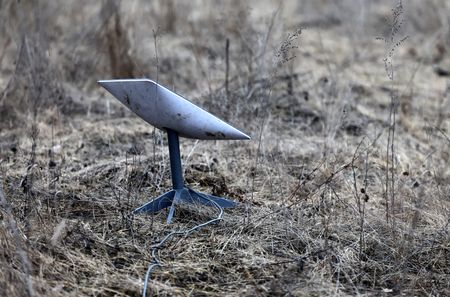By Jan Strupczewski and Yoruk Bahceli
BRUSSELS (Reuters) – The European Union is discussing how to finance a sharp increase in its defence readiness to deter any possible future attack from Russia and become less dependent for security on the United States.
With the European Commission estimating EU defence spending needs at 500 billion euros ($523 billion) over the next 10 years, the solution is likely to include a combination of options, rather than a single one. Here are some of the ideas under discussion:
RELAXING EU SPENDING RULES – NEW STABILITY AND GROWTH PACT
The Commission has said it will soon propose that defence spending be exempt from EU laws that put annual spending limits on governments to gradually lower their public debt and keep their budget deficits below 3% of GDP.
Not all EU governments support the idea, as they say special treatment for defence spending already exists in the rules. What is missing, they say, is a broader definition of defence investment, an issue they would prefer to focus on.
Giving governments leeway to borrow more nationally may widen their deficits, however. This would raise the risk of an adverse bond market reaction in big economies already facing high deficits like France and Italy, Citi economists warn.
But if all EU countries were to get the same exemption on defence spending and all raised borrowing and military investment, the risk as perceived by markets could be more a European one than a national one, limiting the potential repercussions for individual countries, some officials say.
MONEY FROM THE EU’S NEXT LONG-TERM BUDGET FOR 2028-2034
The EU will start negotiating its next seven-year budget from July. The Commission believes that it should provide funds for EU defence projects and therefore that it should be bigger than the roughly 1% of EU GNI, or 1.2 trillion euros, it is now.
But many EU governments argue that while defence spending in the EU budget is worth discussing, the next budget would kick in only in 2028 and the first disbursements would be in 2030 — far too late to start preparing for any potential invasion.
MONEY FROM THE EU’S 2021-2027 BUDGET
The current seven-year EU budget, created well before the Russian invasion of Ukraine, has no proper funds for defence.
But around one-third of it is to equalise the standard of living between regions in the 27-nation EU, and some of that cash can be used for projects that would be somehow linked to defence, like shelters for civilians or strengthening roads and bridges to allow the passage of tanks – it is up to national governments to decide.
NEW JOINT EU BORROWING MODELLED ON RECOVERY FUND
Since 2021, the EU has been jointly borrowing hundreds of billions of euros for grants and loans to EU governments for an economic recovery after the COVID-19 pandemic.
Some officials have argued that such joint EU borrowing could be repeated for defence.
But the idea is a hard sell in Germany, where the Constitutional Court has ruled that the COVID recovery fund had to be a one-off. Some EU officials say new joint EU borrowing might be legally admissible if it did not include grants, only loans.
More EU issuance would be the most welcome option for investors. EU bonds are popular with investors, but their appeal has been limited given new borrowing for the COVID recovery ends in 2026. Making them more permanent could increase demand and lower the EU’s borrowing costs, making defence funding cheaper.
EXISTING RECOVERY FUND MONEY
So far, out of 359 billion euros available in Recovery Fund grants only 197.5 billion has been disbursed, and of the 291 billion available in loans only 108.7 billion has been disbursed.
The Recovery Fund programme ends in 2026 and many countries will not manage to spend all the loans and grants available to them by then on agreed projects linked to the green transition of the economy, digitalisation or resilience.
Officials say, therefore, that around 90 billion euros is likely to remain in unspent loans and low double digits in unspent grants could be re-directed to defence. But the unspent loans and grants still belong to certain countries which would have to agree to either spend them on their own defence or EU defence projects.
A SPECIAL PURPOSE VEHICLE (SPV) TO JOINTLY BORROW AND SPEND
Poland, which holds the rotating EU presidency until June, has been pushing the idea of creating a special purpose vehicle that would be modelled on the euro zone’s bailout fund, the European Stability Mechanism, but open to all who wish to join, also from outside the EU, like Britain or Norway.
The SPV would have paid-in capital and callable capital and borrow on the markets to lend to for defence projects.
However, some investors warn that setting up a brand new issuer will mean that, at least initially, it will have to pay a higher borrowing cost than the EU. Some investors could also push back against buying debt issued for defence.
A REARMAMENT BANK
This idea of a rearmament bank was floated in mid-January by Britian’s former defence chief General Nick Carter, former European Bank for Reconstruction and Development Executive Committee member Guy de Selliers, and Senior Adviser at the Center for European Policy Analysis in Washington Edward Lucas.
Such a bank would be modelled on the EBRD, and, like the Polish SPV idea, open to countries from outside the EU to become shareholders. Under the initial idea, the bank could have 10 billion euros of paid-in capital and 90 billion in callable capital and therefore extend loans of 100 billion euros for defence projects.
($1 = 0.9560 euros)
(Reporting by Jan Strupczewski and Yoruk Bahceli; Editing by Hugh Lawson)










